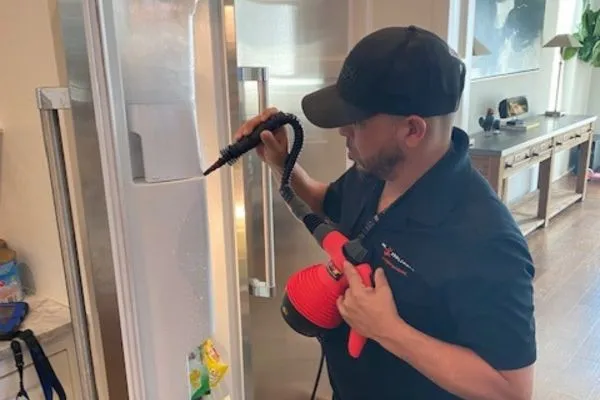Your Washer Won’t Drain? Here’s What To Do

A Flower Mound Homeowner’s Guide to Fixing a Washer That Won’t Drain
If your washer won't drain at home in Flower Mound, you’ll likely be frustrated. It's something that could ruin your day, or just be a minor bump in the road, depending on your schedule. After all, there's nothing more annoying than finding out that you're dealing with clothing soup when you go to move a load from the washer to the dryer.
For those struggling when their washer won't drain, we've put together this list of helpful tips for your washing machine. With this, you can learn more about how to drain your washing machine yourself and when you should call in an appliance repair professional.
Why Your Washer Won’t Drain
Several reasons could be behind the reason why your washer won't drain. These could include a clogged drain hose, a jammed drain hose, a broken drain pump, a lid switch, or a broken belt. Whatever the reason behind the problem might be, you need to drain your washing machine of water before you can attempt troubleshooting the problem—or even hire an appliance repair service to solve it for you.
Your washing machine typically drains water during the spin cycle. How that works is that your washer’s drain pump forces water out from the bottom of the drum and into the washing machine drain hose. Now, the drain hose loops up to the top of the washer, then back down to the drain, which allows for the drum to fill with water. Once the water reaches the bend in the hose, it leaves through the drain.
How to Manually Drain Your Washer When Your Washer Won’t Drain
If you're experiencing the problem that your washer won't drain, then you need to take the needed steps to deal with the water that remains. There are a couple of ways to manually drain your washer when your washer won't drain, and these are:
- Bailing It Out With a Bucket: If you're finding your washer won't drain, then your go-to solution is probably finding a bucket to scoop it out yourself. However, it's a time-consuming and tedious process that's also really hard on your back. That's because you're repeatedly bending over to bail water out of the bottom of your washer's drum.
- Drain With a Hose: If you're looking for an easier way when your washer won't drain, this is the way. Rather than deal with a machine full of water by manually bailing it out with a bucket, let the drain hose and gravity do the heavy lifting for you. What you'll need are a bucket, a screwdriver, needle-nose pliers, and a clamp. You also likely want to have towels on hand in case of drain hose issues.
Washer Won't Drain? Follow These Steps to Drain Your Washer With a Drain Hose
For those looking for an easier way to deal with the problem when a washer won't drain, here are the steps you need to follow to drain the remaining water out of the drum using a drain tube or hose.
Step 1: Turn Off the Power
Obviously, water and electricity don't mix. That's why the first step you need to take is unplugging your washer from its outlet or flipping the switch on the circuit breaker for it. As an additional precaution, you might want to turn off the hot water and cold water connections to your washing machine.
Step 2: Locate Your Washing Machine's Drain Hose at the Back of the Machine
Your washing machine's drain hose is behind your washer, connecting it to the exterior washing machine drain pipe. While locating it, you might notice some potential issues, like a bent or kinked hose. If that's the case, then your washer won't drain properly, because the kinked or bent hose is obstructing the flow of water. If that's the source of the problem, all you need to do is straighten out your drain hose and watch the water flow.
However, if there's nothing wrong with the drain hose, then you're going to want to disconnect it from the washing machine's drain. You'll need to unscrew the hose, and it's best to do this with the clamp holding the hose in place. Importantly, make sure that you keep the hose above the washer drum until it's time to empty the water.
Step 3: Set Up Your Bucket and Drain Hose
Set up your bucket where you won't accidentally knock it over. As a precaution, you might want to place towels around it in case it overflows, or it's knocked over. Once that's done, drop the hose so that it's lower than the washer's drum and put the end of the hose into the bucket.
If your bucket fills up, raise the hose above the washer’s drum so you can empty it safely. Once you have, place the hose back in the bucket to fill it up once again. If your washer won't drain itself completely, then it might take a while to drain it manually.
If you're noticing that the water isn't flowing freely through the drain hose, then chances are that you've got a clogged drain pump filter. If that's the case why your washer won't drain at all, then you need to clean the filter before you can continue draining your washing machine.
Step 4: Check the Hose for Clogs or Blockages
Once you've completely drained out your washer that won't drain, it's time to start checking for a cause. Start by inspecting your drain hose for any blockages that can clog up the drain cycle of your washing machine.
If you're doing this, you'll need to loosen the clamp that connects the hose to the bottom of the drum and inspect the inside. If you spot anything that's blocking either the drain hose or anything connected to it, remove the blockage with the pliers and reconnect the drain hose.
Step 5: Check for a Clogged Washing Machine Drain
Now, if your investigation reveals that the drain hose is clear, then that means you might have the common washer problem of a deeper clog within the drain or a clogged drain filter. Drain clogs are a huge problem for your washer. If this is the case, then you're likely going to need either a drain snake or an appliance repair professional to deal with the problem.
Step 6: Check Your Washing Machine's Drain Pump
Next, you're going to want to check whether you have a faulty water pump for a clog, a broken belt, or an impeller (if your washing machine is a top-loader). You might also have a leak, so check for that, too, during this step. To do so, you'll need to read through the manufacturer's instructions as they'll include a diagram of the location of your washer's drain pump and its various components.
However, if there's a problem with the drain pump, and it's the reason why your washer won't drain, you likely would have noticed unusual noises or that your machine was leaking while running. If you've got a broken water pump or a bad drain pump, you're going to need to call our Flower Mound appliance expert to replace it for you.
Step 7: Check the Lid Switch
To check if your lid switch is working, push it down manually. If there's no clicking sound, that can indicate that the lid switch is broken and needs to be replaced.
Step 8: Check Your Washing Machine's Belts
If your washer won't drain, you'll need to check and see if your machine's belts are damaged. To find the location of these, consult the manufacturer's manual. Checking this requires unscrewing the access panel and checking both the main and pump belts. You'll want to make sure that nothing is corroded, broken, or damaged.
Step 9: Check the Drain Vent
You might not know this, but your washing machine has a drain vent that lets air into it. It helps prevent a vacuum from forming that would prevent your washer from draining properly. If your washer won't drain, then this might be the cause. However, not all washers have a drain vent. If there's a gap where your drain hose enters the drain, then it's not always necessary to include one.
Step 10: Utilize Your Home Warranty’s Coverage
Now, if you've followed all of the above steps and your washer won't drain still, then it's time to make the call for a professional to come in and deal with the problem. This is where your home warranty comes in, as they often cover a washing machine. There's also the chance that your manufacturer has a warrant, and, if so, you should check what it covers.
Washer Won’t Drain? You Might Need the Experts at Mr. Appliance of Flower Mound—Call Today
If your washer won't drain, you might need the help of an expert to solve the problem. That's where Mr. Appliance of Flower Mound comes in. When your washer won't drain properly, we can help by diagnosing the problem and making recommendations on a solution that works for you.
If you're struggling and your washer won't drain and nothing seems to work, give us a call for washing machine repair today!
 Click to call
Click to call


